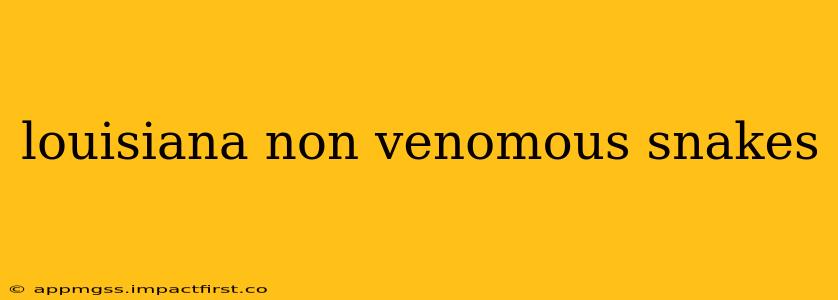Louisiana boasts a rich biodiversity, and its snake population is no exception. While venomous snakes like copperheads and cottonmouths command attention, the state is also home to a fascinating array of non-venomous species. Understanding these snakes is crucial for ensuring safe coexistence and appreciating the intricate web of Louisiana's ecosystem. This guide delves into the common non-venomous snakes found in Louisiana, addressing frequently asked questions to provide a comprehensive understanding.
What are some common non-venomous snakes in Louisiana?
Louisiana's non-venomous snake population is diverse. Some of the most frequently encountered species include:
- Corn Snakes (Pantherophis guttatus): Known for their beautiful patterns and docile nature, corn snakes are popular pets. In Louisiana, you'll find them in a variety of colors and patterns.
- Rat Snakes (Pantherophis spp.): Several rat snake species inhabit Louisiana, including the black rat snake and the gray rat snake. These are beneficial snakes, controlling rodent populations.
- King Snakes (Lampropeltis spp.): King snakes, such as the eastern king snake and the speckled king snake, are known for their striking patterns and their ability to consume other snakes, including venomous ones.
- Black Racers (Coluber constrictor): These sleek, fast-moving snakes are often mistaken for venomous species due to their size and speed, but they are harmless to humans.
- Brown Snakes (Storeria dekayi): These small, slender snakes are often overlooked, but play a vital role in the ecosystem. They are typically brown or grayish-brown in color.
- Garter Snakes (Thamnophis spp.): Several garter snake species are found in Louisiana, characterized by their distinctive stripes. They are primarily aquatic or semi-aquatic.
How can I identify a non-venomous snake in Louisiana?
Identifying snakes requires careful observation and attention to detail. While there are no foolproof methods to distinguish all non-venomous from venomous snakes at a glance, here are some key features to consider:
- Pupil Shape: Venomous snakes typically have elliptical or cat-like pupils, while non-venomous snakes usually have round pupils. This is not a completely reliable indicator, however.
- Head Shape: Venomous pit vipers (like copperheads and cottonmouths) often have triangular heads, whereas non-venomous snakes generally have more rounded or oval heads. Again, this isn't always definitive.
- Heat-Sensing Pits: Pit vipers possess heat-sensing pits between their eyes and nostrils. Non-venomous snakes lack these pits.
- Scales: Examine the scales for patterns and textures. While this isn't a foolproof method, it can be helpful in conjunction with other identifying features.
- Overall Appearance: Consider the snake's size, color, markings, and behavior. Field guides and online resources (with caution!) can be helpful in identification.
It's important to note that relying solely on these visual characteristics can be unreliable. If you are unsure, it is best to err on the side of caution and assume the snake is venomous.
Are there any dangerous non-venomous snakes in Louisiana?
While Louisiana's non-venomous snakes are generally harmless, some larger species, like rat snakes, might bite if threatened. Their bites are rarely serious, causing minor discomfort similar to a cat scratch. They pose no significant medical threat.
What should I do if I encounter a snake in Louisiana?
The best course of action when encountering a snake is to observe it from a safe distance and leave it undisturbed. Never try to handle a snake unless you are a trained herpetologist. If the snake is in a location where it poses a threat to humans or pets, contact animal control or a wildlife removal service.
What role do non-venomous snakes play in the Louisiana ecosystem?
Non-venomous snakes play a vital role in maintaining the balance of Louisiana's ecosystem. They are crucial predators, controlling rodent populations, insect numbers, and even other snake populations. Their presence contributes to a healthy and functioning environment.
How can I learn more about Louisiana snakes?
Numerous resources are available for learning more about Louisiana snakes. Local universities, nature centers, and herpetological societies often offer educational programs and materials. Reputable field guides and online databases can also be helpful, but always cross-reference information from multiple sources. Remember to use caution when using online resources to identify snakes, as misidentification is possible.
Disclaimer: This information is for educational purposes only. Always exercise caution when encountering snakes in the wild and consult with professionals if you have concerns about snake identification or safety. This information does not constitute professional advice.
